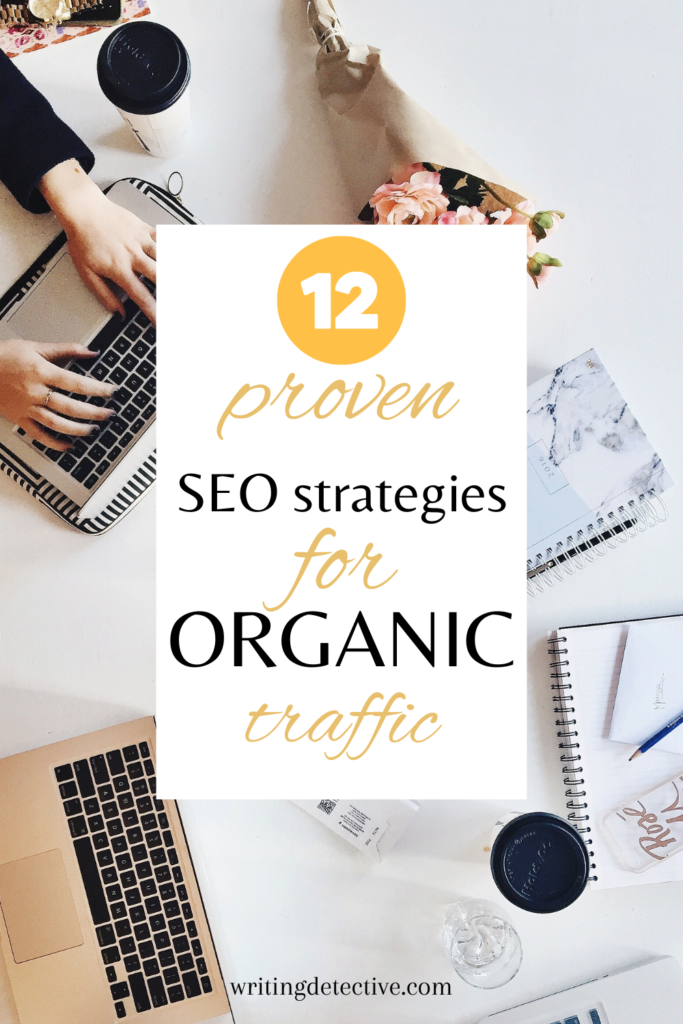Are you tired of pouring your heart and soul into creating amazing blog content, only to have it languish in the depths of search results, unseen by your target audience? You’re not alone. With millions of blog posts published every day, it can feel like an uphill battle to get your content noticed. But fear not! By implementing some proven strategies to optimize your blog posts for search engines, you can significantly improve your rankings, drive more organic traffic, and grow your audience.

In this comprehensive guide, we’ll walk you through 12 actionable steps you can take to supercharge your blog’s SEO and start seeing real results. Let’s dive in!
- Conduct Thorough Keyword Research
The foundation of any successful SEO strategy is solid keyword research. Before you start writing, take the time to identify the keywords and phrases your target audience is using to search for content related to your topic. Use tools like Google Keyword Planner, SEMrush, or Ahrefs to uncover valuable keyword insights, including search volume, competition level, and related keywords. Focus on long-tail keywords (3+ word phrases) that are highly relevant to your content and have lower competition. Incorporate these keywords naturally throughout your post, including in the title, headings, meta description, and body text. But avoid keyword stuffing, which can actually hurt your rankings. - Craft Compelling, Keyword-Rich Titles
Your blog post title is often the first thing potential readers will see in search results, so it needs to be attention-grabbing and clearly convey the value of your content. Aim for titles that are around 60 characters long so they don’t get cut off in search snippets. Front-load your title with your primary keyword, but make sure it still reads naturally and entices clicks. Use powerful words and phrases like “How to,” “X Tips for,” “The Ultimate Guide,” “Proven Strategies,” etc. to communicate the actionable, useful nature of your post. A great title can make the difference between a user clicking through to your content or scrolling past. - Write High-Quality, In-Depth Content
One of the most important ranking factors for Google is the quality and depth of your content. Gone are the days of thin, 300-word posts – today’s top-ranking blog posts are long-form, providing comprehensive coverage of the topic at hand. Aim for a minimum of 1,000-1,500 words, but don’t be afraid to go even longer if the subject calls for it. Use short paragraphs, subheadings, bullet points, and images to break up the text and improve readability. Provide real value to your readers by offering actionable advice, citing credible sources, and covering the topic from multiple angles. When you create content that truly helps people, search engines will take notice. - Optimize Your Meta Description
While meta descriptions don’t directly impact search rankings, they do influence click-through rates from SERPs. A compelling meta description can entice searchers to choose your post over others. Keep your meta descriptions between 150-160 characters and treat them like ad copy – use active voice, include a clear call-to-action, and highlight the unique value proposition of your post. Incorporate your primary keyword organically, but again, avoid stuffing. Your meta description should give searchers a taste of what they’ll find in your post and leave them wanting more. - Use Header Tags Strategically
Header tags (H1, H2, H3, etc.) provide a hierarchical structure to your post, making it easier for both readers and search engines to understand the main topics and subtopics covered. Your post title should be wrapped in an H1 tag, and your subheadings should use H2 and H3 tags as appropriate. Incorporate relevant keywords into your header tags where it makes sense, but keep them concise and descriptive above all else. Well-structured content with clear headings is more likely to engage readers and earn backlinks, both of which can boost your search rankings. - Optimize Your Images
Visual content is a powerful way to engage readers and break up lengthy blocks of text, but it’s important to optimize your images for search engines as well. Start by choosing relevant, high-quality images that enhance your content. Then, customize the file name of each image to include a relevant keyword. For example, instead of “IMG_4820.jpg”, use “on-page-seo-tips.jpg.” Next, add descriptive alt text to each image, which helps search engines understand what the image portrays. This is especially important for accessibility and for users who have images disabled. Finally, compress your images to reduce file size without sacrificing quality, which can help improve page load speed (more on that later). - Link Internally to Relevant Posts
Internal linking is a simple but effective way to boost your blog’s SEO. By linking to other relevant posts on your site, you help search engines understand the structure and hierarchy of your content. You also encourage readers to spend more time exploring your site, which can reduce bounce rates and increase engagement. When adding internal links, use descriptive anchor text that gives context to the linked page. For example, instead of “click here”, use phrases like “learn more about on-page SEO” or “get tips for keyword research”. Be strategic with your internal linking and focus on connecting related pieces of content that provide additional value to readers. - Build High-Quality Backlinks
Backlinks from other reputable websites are a major ranking factor for search engines. When other sites link to your content, it signals to Google that your post is valuable and authoritative. But not all backlinks are created equal – focus on earning links from high-quality, relevant websites in your niche. Some effective strategies for building backlinks include guest posting on industry blogs, reaching out to influencers and thought leaders, and creating highly shareable content like infographics or original research. Avoid spammy tactics like buying links or participating in link schemes, which can actually hurt your rankings. Instead, focus on creating genuinely valuable content that other sites will want to link to naturally. - Maximize Page Load Speed
In today’s fast-paced digital world, users expect websites to load quickly and smoothly. Page load speed is not only important for user experience, but it’s also a ranking factor for search engines. Slow-loading pages can negatively impact your SEO and drive visitors away. To improve page load speed, start by choosing a fast, reliable hosting provider and using a lightweight theme or framework. Optimize your images as described earlier, and minify your HTML, CSS, and JavaScript files to reduce their size. Use caching and content delivery networks (CDNs) to further speed up load times. Tools like Google PageSpeed Insights can help you identify specific areas for improvement. - Make Your Site Mobile-Friendly
With more and more users accessing the web from mobile devices, having a mobile-friendly website is no longer optional. Google has shifted to mobile-first indexing, meaning it primarily uses the mobile version of your site for ranking and indexing purposes. To ensure your blog is optimized for mobile, start by using a responsive design that adapts to different screen sizes. Make sure your content is easily readable on smaller screens, with font sizes that are large enough and clickable buttons. Avoid using Flash or other technologies that aren’t supported on mobile devices. Test your site on various devices and use Google’s Mobile-Friendly Test tool to identify any issues. - Leverage Social Media
While social media signals don’t directly impact search rankings, they can indirectly influence your SEO by driving traffic, increasing brand awareness, and encouraging backlinks. Share your blog posts on relevant social media platforms and engage with your followers to build a loyal audience. Encourage readers to share your content with their own networks, and make it easy for them to do so by including social sharing buttons on your posts. Participate in industry conversations and build relationships with influencers who may be willing to share your content with their followers. The more people who see and engage with your content on social media, the more likely it is to earn backlinks and other SEO-boosting signals. - Monitor and Analyze Your Results
Finally, it’s crucial to track your blog’s SEO performance over time to see what’s working and what’s not. Use tools like Google Analytics and Search Console to monitor your traffic, rankings, and user engagement. Pay attention to metrics like organic traffic, bounce rate, time on page, and backlinks. Use this data to identify your top-performing posts and look for patterns in what resonates with your audience. Continuously refine your SEO strategy based on your findings, and don’t be afraid to experiment with new tactics. By regularly monitoring and analyzing your results, you can make data-driven decisions to optimize your blog for even better search rankings.
Optimizing your blog posts for search engines may seem daunting at first, but by following these 12 proven strategies, you can significantly improve your rankings and drive more organic traffic to your site. Remember, SEO is an ongoing process, not a one-time fix. Consistently creating high-quality, keyword-rich content, building high-quality backlinks, and staying up-to-date with the latest best practices are key to long-term success.
But don’t get discouraged if you don’t see results overnight – SEO takes time and persistence. Focus on providing genuine value to your readers and building a strong, engaged audience. As you consistently implement these strategies and create content that resonates with your target market, you’ll start to see your search rankings climb and your organic traffic grow.

It’s also important to remember that SEO is just one piece of the puzzle when it comes to building a successful blog. While it’s crucial for driving targeted traffic, it’s equally important to focus on creating a great user experience, encouraging engagement and community, and monetizing your blog in a way that aligns with your goals and values.
Consider integrating other traffic-driving strategies alongside SEO, such as paid advertising, influencer marketing, or content syndication. Experiment with different content formats like videos, podcasts, or webinars to appeal to a wider range of learning styles and preferences. And don’t forget the power of email marketing for nurturing relationships with your audience and driving repeat traffic to your site.
Ultimately, the key to a thriving blog is to focus on serving your audience first and foremost. When you create content that genuinely helps people solve problems, answer questions, or enrich their lives in some way, the search rankings and traffic will follow. Stay committed to continuous learning and improvement, and don’t be afraid to take risks and try new things.
By approaching your blog with a strategic, audience-centric mindset and consistently implementing proven SEO best practices, you’ll be well on your way to higher search rankings, increased organic traffic, and a growing, engaged community of readers. So start optimizing your posts today and watch your blog soar to new heights!
Some Additional Tips to Keep in Mind:
- Use schema markup: Schema markup is a type of code that helps search engines better understand the content on your page. By adding schema markup to your blog posts, you can provide additional context and information that can help your content stand out in search results.
- Optimize for featured snippets: Featured snippets are the brief answers that often appear at the top of Google search results. By optimizing your content to directly answer common questions related to your topic, you increase your chances of landing a featured snippet and driving more click-throughs to your post.
- Update and refresh old content: Don’t let your old blog posts gather dust – regularly updating and refreshing your existing content can help improve its search rankings and drive fresh traffic. Look for opportunities to add new information, update statistics, or expand on certain points to keep your content relevant and valuable.
- Promote your content beyond social media: While social media is a great tool for promoting your blog posts, don’t stop there. Look for other opportunities to get your content in front of new audiences, such as by submitting guest posts to other blogs in your niche, participating in online communities and forums, or even reaching out to journalists and media outlets when appropriate.
- Focus on user engagement: Search engines pay attention to how users interact with your content, so it’s important to focus on engagement metrics like time on page, bounce rate, and comments. Encourage readers to engage with your posts by asking questions, inviting feedback, and responding to comments promptly.
By following these additional tips and consistently implementing the 12 strategies outlined above, you’ll be able to create a strong, sustainable SEO foundation for your blog that drives real results. Remember, success in blogging and SEO requires patience, persistence, and a willingness to adapt and evolve over time. But by staying focused on providing value to your audience and committed to continuous improvement, you can build a thriving blog that stands the test of time.
Need help optimizing your blog or getting high quality backlinks? Contact us today.






